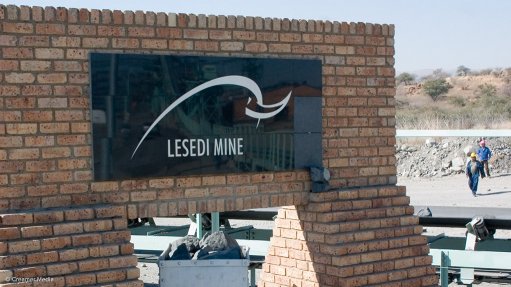
Photo by: Duane Daws
JOHANNESBURG (miningweekly.com) – Interruptions in production, lower sales volumes, higher production costs and one-off items impacted negatively on International Ferro Metals’ (IFM’s) results for the six months ended December 31, resulting in a net loss of R175.6-million, compared with a net profit of R32.3-million in the prior comparable period.
IFM CEO Chris Jordaan added that market conditions had also negatively impacted results, with the benchmark ferrochrome price having fallen by more than 6% in the period under review.
The London-listed miner on Monday reported that its ferrochrome production for the six months to December had been 16% lower year-on-year at 98 016 t, owing to planned maintenance shutdowns at its operations, a Section 54 stoppage by the Department of Mineral Resources (DMR) in November and owing to trials to assess the viability of using silicon carbide as an alternative reductant in the smelting process.
IFM had lost 4 000 t of production in November, after the DMR had ordered it to temporarily halt the operation of its two furnaces and pelletiser following a health and safety incident that led to two employees being exposed to carbon monoxide gas.
Meanwhile, the company’s Lesedi underground mine continued its ramp-up in production in line with a revised, accelerated schedule, while the company’s Rooderand mine produced 8 400 t run-of-mine during the half, ahead of previous guidance.
Ferrochrome sales, however, decreased to 101 700 t in the six months under review, compared with the 109 623 t sold in the six months to December 31.
Ferrochrome production costs for the six months were R8.15/lb - in line with guidance.
IFM, meanwhile, expected its cogeneration plant to restart operations in the second quarter of the 2015 calendar year, following modifications to its gas supply circuit.
OUTLOOK
Jordaan noted that IFM’s operations were “already” showing significantly improved operating rates in the beginning of the second half of the financial year.
“The revised ore feed to the furnaces, augmented by improved quality supply of key reductants are contributing to this improved performance,” he explained.
He added that this was expected to continue into the second quarter of the 2015 calendar year.
“Added to this, production costs should further decrease and management is confident that this will continue into the rest of the year. Further cost reduction initiatives are being implemented and are specifically focussed on reducing overheads and related fixed costs.”
Jordaan noted that improved production and real fixed cost reduction would result in lower per unit fixed costs.
“We expect the second half [of the financial year] to show a substantial improvement and be cash generative. So far, the results are encouraging,” he enthused.
He stated that securing supply of chrome ore was a “growing challenge” for the industry, as upper group two supply remained static, while global chrome ore demand was expected to rise by one-million tonnes this year.
“A lack of adequate investment in new chrome ore mines and the high cost of developing these mines, should drive an upwards revision in market prices for chrome ore and subsequently ferrochrome prices. We remain confident in our strategy of ensuring an uninterrupted long-term competitive ore supply for ferrochrome production to meet future market demand,” Jordaan commented.